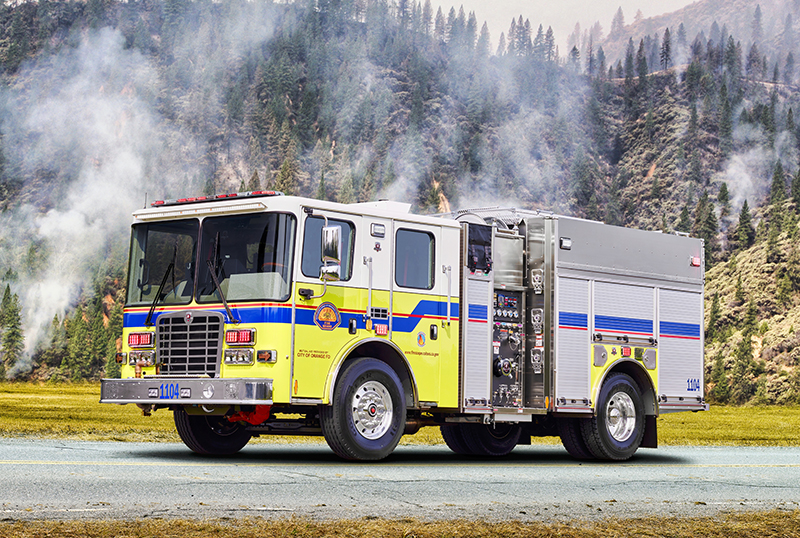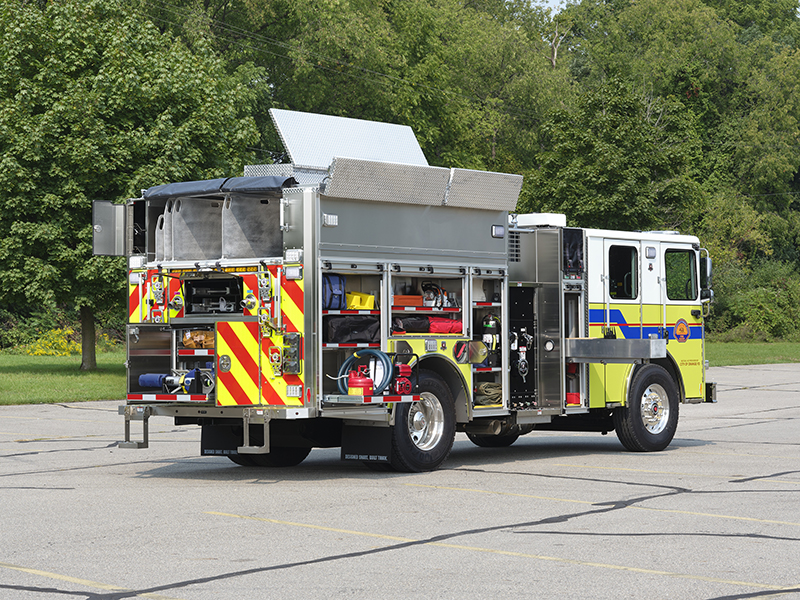
The California Governor’s Office of Emergency Services (CAL OES) has taken delivery of seven HME Ahrens-Fox Type 1 wildland urban interface (WUI) engines with a revised design that includes longer bodies, a revamped cab, and more storage space and anticipates purchasing another eight new-style Type 1 WUI engines from the company with funds from its 2022-2023 fiscal year budget.
Mitch Higgins, CAL OES deputy chief, says that CAL OES serves as the state’s leadership hub during all major emergencies and disasters, including responding, directing, and coordinating state and federal resources and mutual-aid assets across all of California’s regions. For wildfires, Higgins notes that the CAL OES Fire and Rescue Branch uses the California Fire and Rescue Mutual Aid System to deploy its fleet of more than 270 engines (Type 1, Type 3, and Type 6) to cover more than 60 local fire agencies across the state to build on the state’s capacity to respond to incidents of all types.
Higgins says that CAL OES purchases the engines and assigns them to a local government for use. “We buy fully outfitted engines except for self contained breathing apparatus (SCBA) and emergency medical services (EMS) equipment,” Higgins observes. “We give the engines to the local fire agencies for free, and they are responsible for doing minor maintenance on the rigs and can use them when a front-line engine goes out of service. The agencies staff the engines and have to accept deployment through the California Fire Assistance Agreement they sign, which says the engines go out on deployment for a minimum of seven days but can be extended to 14 and 21 days, during which the agency will usually rotate crews.”
Ed Boring, fleet sales manager for HME Ahrens-Fox, says the new Type 1 WUI engines that his company built for CAL OES are on HME Ahrens-Fox 1871-SFO chassis and SFO-MFD cabs with seating for four firefighters in nonSCBA seats. They are powered by Cummins L9 engines and Allison 3000 EVS automatic transmissions. Each rig has a 1,500-gallon-per-minute (gpm) Darley LDM midship-mounted pump, an 800-gallon water tank, a 20-gallon foam cell, a FoamPro 2001 foam proportioning system, and a Darley 1-1/2-AGE 100-gpm auxiliary pump for pump and roll operations.

1 CAL OES took delivery of seven Type 1 WUI engines built by HME Ahrens-Fox in a revised version that includes longer bodies, a revamped cab, and more storage space. (Photos courtesy of HME Ahrens-Fox.)
department
California Governor’s Office of Emergency Services (CAL OES)
Strength: More than 60 local fire agencies across California.
Service area: Serves as the state’s leadership hub during all major emergencies and disasters. This includes responding, directing, and coordinating state and federal resources and mutual-aid assets across all regions. For wildfires, the CAL OES Fire and Rescue Branch facilitates the California Fire and Rescue Mutual Aid System to deploy its fleet of more than 270 engines to more than 60 local partners across the state to build on the state’s capacity to respond to incidents of all types.
Other apparatus: 114 Type 1 engines with 1,250-gpm pumps, 800 gallon water tanks, 20 gallon foam tanks, Darley 1-1/2AGE auxiliary pumps; 67 Type 3 engines with 500-gpm pumps, 500-gallon water tanks, auxiliary pumps; 79 Type 6 engines with auxiliary pumps, 300-gallon water tanks; 12 water tenders (tankers) with various tank sizes; 12 hazardous material response units; six support units; 13 swiftwater boats; 19 rescue system trailers.

2 The Type 1 WUI engines are powered by Cummins L9 engines and Allison 3000 EVS automatic transmissions.

3 Each HME Ahrens-Fox Type 1 WUI engine built for CAL OES has a 1,500-gpm Darley LDM midship-mounted pump, an 800-gallon water tank, a 20-gallon foam cell, a Darley 1-1/2AGE 100-gpm auxiliary pump for pump and roll, and a FoamPro 2001 foam proportioning system.

4 The SCBA were removed from the backs of seats in the crew cab and secured on two SCBA trees located behind the driver and officer seats.

5 CAL OES added a coffin compartment on each unit to carry USAR equipment and a dedicated bay in the hosebed to carry the firefighters’ deployment gear.
specs
HME Ahrens-Fox Model 18 Type 1 WUI Engines
- HME Ahrens-Fox Model 1871-SFO chassis and SFO MFD cabs
- Seating for four firefighters
- Cummins L9 engines
- Allison 3000 EVS automatic transmissions
- Darley LDM 1,500-gpm midship-mounted pumps
- 800-gallon water tanks
- 20-gallon foam cells
- Darley 1-1/2AGE 100-gpm auxiliary pumps for pump-and-roll capability
- FoamPro 2001 foam proportioning systems
“In the wildland environment, we need to have relatively small engines because of the mountainous areas where we are often fighting structural and wildland fires,” Higgins points out. “These newest Type 1 WUI engines from HME Ahrens-Fox are designed around responding not only to structural and wildland fires but also for earthquake response and the fires that inevitably follow them.”
He notes that the new rigs have the same pump as previous models but now carry 4-inch large-diameter hose (LDH) instead of 3-inch hose in the hosebeds. “We added a coffin compartment on top of the engine, and for earthquake response, we now carry an urban search and rescue (USAR) component,” Higgins says, “including a HURST Jaws of Life eDRAULIC cutter, spreader, rams, and a penetrator ram; rope rescue equipment; and all the other USAR equipment, minus the lumber.” Higgins adds that the length of the cab was increased from previous versions to give firefighters more room during the drive to far-reaching deployment areas. “Also, we moved the SCBA from the seats to two SCBA trees located behind the driver and officer seats.”
Boring points out that the engines carry two 1¾-inch crosslays over the pump and a 1¾-inch line in a front bumper compartment, have 2½-inch discharges on the left and right sides of the pump panel, have a 4-inch discharge on the right side, and carry an Akron Brass Company Apollo deck gun.
“The hosebed is set up to carry a preconnect of 1¾-inch hose, a 1¾-inch hose dead lay, 600 feet of 2½-inch hose, an empty cell for deployment gear, and 800 feet of 5-inch LDH,” Boring notes. “There are two 6-inch 10-foot hard sleeves in an enclosed compartment on the left rear of the truck; a coffin compartment on top on the right side; and a 24-foot two-section extension ladder, a 14-foot roof ladder, a 10-foot folding attic ladder, and two pike poles in the ladder tunnel.”
Boring says that the body on the new Type 1 WUI engines don’t have a beavertail, allowing the extended body to increase storage space. “The rear compartment is set up to carry their HURST eDRAULIC rescue tools and chargers for extra batteries,” he says. “And in a sliding tray above the tools is the space for structural collapse equipment.” All lighting on the Type 1 engines is Whelen LED lighting, Boring adds, including warning lighting, a brow light, and scene spot and flood lighting.
ALAN M. PETRILLO is a Tucson, Arizona-based journalist, the author of three novels and five nonfiction books, and a member of the Fire Apparatus & Emergency Equipment Editorial Advisory Board. He served 22 years with the Verdoy (NY) Fire Department, including in the position of chief.

